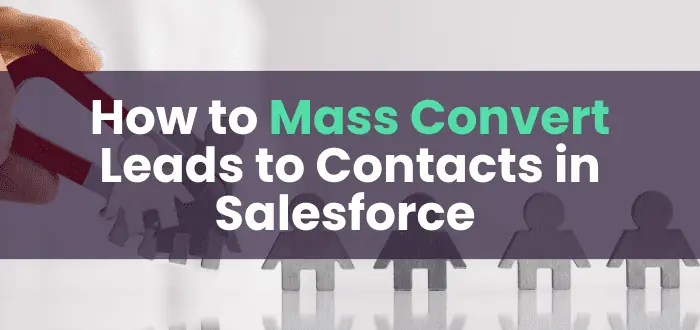June 22, 2023
How to Mass Convert Leads to Contacts in Salesforce

Are you looking to streamline your lead conversion process in Salesforce? Converting leads to contacts individually can be time-consuming and tedious. Fortunately, we have some valuable insights to help you mass convert leads to contacts efficiently.
To date, Salesforce does not provide a built-in feature for mass converting leads to contacts directly. The standard Salesforce functionality allows you to convert leads one at a time. DataLoader, which makes you export and reimport updated records, or an Apex Trigger, which requires programing, are the only workarounds for Salesforce not requiring a 3rd party application. Both of these options are time-consuming and require a certain level of patience and skill set.
For bulk lead conversion, we recommend looking into third-party applications, as it will be less time intensive and offer additional functionality to make your life easier. Say goodbye to manual mistakes and hello to reliable data!
In this article, we'll explore the benefits of mass conversion, explain the key differences between leads and contacts, highlight common mistakes to avoid, and introduce you to our third-party application, Cloudingo, to simplify the conversion process. Let's dive in!
7 Benefits of Mass Converting Leads to Contacts
- Time Efficiency: Manually converting leads one by one can be a time-consuming task. With mass conversion, you can convert multiple leads simultaneously, saving you precious time and effort.
- Improved Data Accuracy: When manually converting leads, there's always a risk of human errors, leading to inconsistent or inaccurate data. Mass conversion reduces this risk by streamlining the process and automating the conversion, ensuring a seamless transfer of information from leads to contacts.
- Streamlined Workflow: Repetitive tasks can hinder your productivity and slow down your sales process. Mass conversion eliminates the need to convert each lead individually, freeing up your time to focus on more important activities. By streamlining your workflow, you can boost efficiency and make the most of your valuable resources.
- Enhanced Productivity: Speed is crucial in sales, and mass conversion enables you to quickly convert leads to contacts. This increased productivity empowers your sales team to engage with contacts promptly, potentially resulting in faster conversions and stronger customer relationships. Get ready to supercharge your sales efforts!
- Better Reporting and Analysis: Accurate data is the foundation of insightful reporting and analysis. By converting leads in bulk, you ensure that your reports are based on complete and up-to-date information. This empowers you to evaluate lead conversion rates, forecast your pipeline, and track other essential sales metrics with confidence.
- Consistency in Data Mapping: Maintaining data integrity and uniformity is vital in any CRM system. Mass converting leads allows you to define standard data mapping and conversion rules. This ensures consistent mapping of lead fields to contact fields, guaranteeing data integrity and uniformity throughout your Salesforce system.
- Scalability: Whether you're dealing with a high lead influx or executing data migrations, mass conversion provides scalability. You can efficiently convert a large volume of leads without compromising speed or accuracy. Seamlessly handle extensive data sets and conquer any conversion challenge that comes your way.
While mass converting leads offers incredible benefits, it's crucial to review and validate your data mapping and conversion settings to ensure a seamless transfer of lead information to contact records. We also recommend performing testing and quality checks before executing the mass conversion process to maintain data accuracy.
What is the difference between a lead & contact in Salesforce?
Leads and contacts are two distinct objects within Salesforce that represent different stages of a customer or prospect's journey.
What are leads in Salesforce?
Leads are potential customers or prospects who have shown interest in your products or services but haven't been qualified as sales opportunities yet. They are individuals or entities you haven't established a business relationship with. Leads are stored in the Lead object in Salesforce and have their own set of fields to capture relevant information. You can assign leads to sales representatives for further qualification and nurturing. The lead management process involves converting leads into contacts, accounts, and opportunities when they meet the criteria for sales engagement.
What are contacts in Salesforce?
Contacts represent individuals or entities with whom you have established a business relationship. They are typically associated with existing customers, clients, or individuals you actively engage with. Contacts are stored in the Contact object in Salesforce and have fields to capture personal information and relevant details. Contacts can be associated with an account, representing the organization or company they are affiliated with. Managing customer relationships, tracking communication, and storing customer-related information are primary functions of contacts.
In summary, leads are potential customers in the early stages of the sales process, while contacts represent established relationships. Leads are converted into contacts, accounts, and opportunities when they meet specific criteria and are ready for further engagement and conversion into sales opportunities.
How to bulk add leads in Salesforce
Streamline the bulk addition of leads in Salesforce with Cloudingo's import tool. This powerful tool checks for existing records, merges data when matches are found, and supports Leads, Contacts, Accounts, Person Accounts, and custom objects. By defining data overriding rules and performing multiple scans against filters, you can ensure accurate data management. Additionally, the Find Data tool enables pre-import analysis to identify potential matches without merging or inserting new records. Simplify your lead addition process and maintain data integrity with Cloudingo's import tool for Salesforce.
How to mass convert leads in Salesforce
Cloudingo offers several options for mass converting Leads into Contacts and Accounts. We will provide an overview of the three available mass convert options and recommended order of filter execution to prevent duplicate records during the conversion process.
Option 1: Dedupe Lead to Contact Filters
After running your merge filters, the first conversion filter you should run is the Dedupe Lead to Contact filter.
- This filter checks if the Lead already exists as a Contact and will prevent creating a new, duplicate Contact during the conversion process.
- This filter is equivalent to Salesforce's 'Attach to existing Account' and 'Attach to existing Contact' options during the conversion process.
- Build convert filters and convert rules to identify matches and tell Cloudingo how to convert records.
Option 2: Dedupe Lead to Account Filters
After running the Dedupe Lead to Contact filter, the next conversion filter you should run is the Dedupe Lead to Account filter.
- This filter checks if the Lead already has an existing Account (without a matching Contact identified in your Lead to Contact filters already processed) and will prevent creating a duplicate Account during the conversion process.
- This filter will create a new Contact record (from the Lead) under the identified Account, but it does not check for existing Contacts during the conversion process.
- This filter is equivalent to Salesforce's 'Create a new Contact' and 'Attach to existing Account' options during the conversion process.
- Build convert filters and convert rules to identify matches and tell Cloudingo how to convert records.
Option 3: Data Maintenance Mass Convert
The Data Maintenance Mass Convert option should always be run after processing all dedupe convert filters.
- This filter may do very basic checks against Account Name only during the conversion process, but the checks are minimal and only prevent duplicate inserts of Accounts during a mass conversion process.
- This filter is not designed to find existing matches to convert into, and it will create both a new Contact and a new Account once a Lead has reached a defined threshold.
- This filter is equivalent to Salesforce's 'Create a new Contact' and 'Create a new Account' options during the conversion process.
Scheduling Tip: When scheduling automated convert filters, it's recommended to stagger the run times after the merge filter run times. Lead to Contact filters should be scheduled to run first, followed by Lead to Account filters, and finally, Data Maintenance convert filters (if applicable). This allows time for each filter to complete before the next one starts.
6 common mistakes when mass converting leads to contacts
During the mass lead conversion process, certain mistakes can hinder your success. Here are some common pitfalls to watch out for:
- Incomplete or Incorrect Data Mapping: Ensure you correctly map lead fields to contact or account fields to prevent missing or mismatched data during the conversion process. Take the time to review and validate your field mappings for accurate information transfer.
- Missing Required Fields: Salesforce has specific fields that are required for contact creation. Failing to include these fields or leaving them blank during conversion can lead to errors or incomplete contact records. Make sure to identify and provide values for all mandatory fields to maintain data integrity.
- Duplicate Contacts: Handling duplicate leads or existing contacts appropriately is crucial. Mass converting duplicate leads without proper identification and deduplication processes can result in the creation of duplicate contacts, leading to data integrity issues. Implement effective duplicate management strategies to avoid such complications.
- Unqualified Leads: Converting leads without proper qualification or evaluation can lead to irrelevant or low-quality contacts. Ensure leads meet necessary criteria before converting them to contacts, accounts, or opportunities, ensuring you focus on valuable prospects.
- Lack of Testing: Testing the mass conversion process with a smaller sample set of leads is essential. It helps identify and rectify any issues, errors, or inconsistencies in conversion settings, data mapping, or validation rules before executing the conversion for a larger set of leads. Test your conversion process for data accuracy and prevent unintended consequences.
- Insufficient Data Validation: Before initiating mass conversion, thoroughly validate the data to be converted. Check for inconsistencies, missing information, or data errors in the lead records. Ensuring data accuracy through comprehensive validation is critical for successful conversions.
Mass convert leads to contacts in Salesforce with Cloudingo
To simplify your lead-to-contact conversion process in Salesforce, you can leverage third-party applications like Cloudingo. With Cloudingo, you can effortlessly mass update records, fill in missing information, reassign records, adjust lead scores, and more. Delete records in bulk and get rid of junk records, such as leads with no email or activity, to keep your database clean.
Cloudingo offers features like converting leads to new or existing contacts or accounts, assigning them to campaigns, reassigning territories, and much more—all accomplished with just a few clicks. Streamline your mass conversion process and maximize your efficiency with this powerful tool.
Mastering the art of mass converting leads to contacts in Salesforce is key to effective customer management. By embracing mass conversion, you'll save time, enhance data accuracy, streamline your workflow, improve productivity, enable better reporting and analysis, ensure consistency in data mapping, and achieve scalability. Remember to avoid common mistakes, validate your data, and consider leveraging third-party applications like Cloudingo to simplify your conversion process. Start implementing these strategies today and unlock the full potential of Salesforce for your business success!





